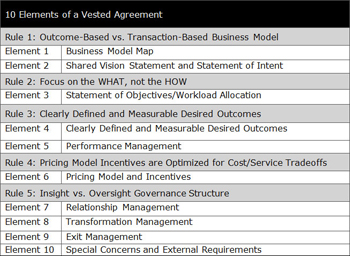Vested Outsourcing’s Game-Changing Model
Add bookmark
Supply chains are longer, more complex and, as we have seen from the Japan earthquake and tsunami earlier this year, more fragile than ever.
The stakes are high: When an outsourcing relationship goes wrong, it can cost huge sums of money, erode market share, and ruin consumer confidence in a company or brand.
In today’s uncertain and unsettling financial and economic climate it is more important than ever to structure outsourcing deals that produce relationships that are reliable, flexible and trustworthy. Unfortunately, most companies have fallen into the same old price-centric, transaction-based way that stresses a me-first, I-win-you-lose approach to business deals simply won’t work anymore. What is needed is a better way to outsource.
And that is exactly what the United States Airforce asked the University of Tennessee to explore. University researchers studied some of the worlds most successful outsourcing deals and codified the rules to success in an outcome-based hybrid business model researchers coined “Vested Outsourcing”. Developed through extensive research and fieldwork by the University of Tennessee, the Vested model offers a different approach to forming and managing the outsourcing relationship between company and service provider, one that is based on collaboration, communication, innovation and trust—where all the parties have a vested interest in successfully achieving clearly defined outcomes.
The Vested model employs Five Rules designed to transform the outsource partnership and encourage innovation, moving it beyond the traditional transaction-based model that is based on lowest possible labor and transaction costs, while avoiding the common ailments that can hinder or derail even the most promising outsource relationship.
The Five Rules are:
- Focus on Outcomes, Not Transactions
- Focus on the What, Not the How
- Agree on Clearly Defined and Measurable Outcomes
- Optimise Pricing Model Incentives
- Governance Structure Should Provide Insight, not Merely Oversight
The Five Rules are linked to Ten Elements designed to take practitioners through the Vested Outsourcing implementation process in a coherent, coordinated and systematic way—from identifying the business, sharing the vision, stating intentions, to managing and governing the enterprise. The elements are the foundation of a successful outsourcing relationship.
The table shows the linkage and interaction between the Rules and their Elements:

In the Vested model the company and the service provider use the five rules and their ten elements to form a win-win relationship in which they are vested in each other’s success.
A good example of this in the pharma world is illustrated in the six-year outsourcing relationship between Valeant Pharmaceuticals and Kenco Logistics Services. Their relationship, and especially Valeant’s emergency shipment program, embodies Vested principles, as related in a DC Velocity article last year. It literally saves lives. Their relationship was recently restructured to accommodate some key changes in Valeant's distribution center situation. Almost of necessity this required that their relationship be one based on the Vested ideas of close collaboration, rapid communication, flexibility and trust.
Valeant manufactures Virazole, the only drug available for infants and children with respiratory syncytial virus (RSV).The University of Wisconsin Medical Center in Madison encountered a rare instance in which two infants had been hospitalised with severe cases of RSV. The infants needed to complete their treatments by midnight in the Central Time Zone, and the hospital did not have any more doses available. Valeant’s longtime logistics service provider, Kenco, jumped into action to solve the problem. Normal shipment procedures for a rush order from Kenco’s distribution center in
Chattanooga, TN, would mean getting the medicine to the hospital by 2 AM. This was obviously too late. James Levi, Kenco’s warehouse supervisor, found a direct flight to Chicago arriving at 6:50 PM local time. He also organised a courier to meet the plane and rush the medicine to the hospital by 10:30 PM—90 minutes before the last required treatment. As harrowing as the experience was, this was hardly an unprecedented situation for Valeant.
For Valeant, having a service provider such as Kenco and employees like James Levi who are empowered to use their judgment and expertise to solve problems, is a key part of the decision criteria when determining the value of working with a service provider.
Shared values and objectives are critical elements of a Vested Outsourcing agreement. In addition there has to be a flexible, insightful governance framework (Rule 5), a cultural fit and a focus on desired outcomes that allows the service provider to do what it does the best without interference or second-guessing and with ultimate trust because lives are at stake.
Valeant and Kenco focused together on outcomes, not transactions (Rule 1) and they focused on the what (Rule 2)—what needed to be done right then.
In essence they have a Vested relationship for all the right reasons, right from the start and starting from the top down.
True collaboration is the key game-changing element that Vested Outsourcing brings to the table, because collaboration is a term that is often repeated but seldom implemented effectively.Collaborate on mutually beneficial rate and service outcomes; move from the cutthroat me-first “win” mentality to the “win-win” by vesting in each other’s success through trust and loyalty.
It can be done; it’s time to change the game.
Links:
www.vestedoutsourcing.com
http://www.vestedoutsourcing.com/books/
http://www.vestedoutsourcing.com/category/5-rules/
http://www.vestedoutsourcing.com/category/10-ailments/
http://www.dcvelocity.com/articles/20100907emergency_parcel_shipments/
http://www.pharma-iq.com/
[inlinead]




















